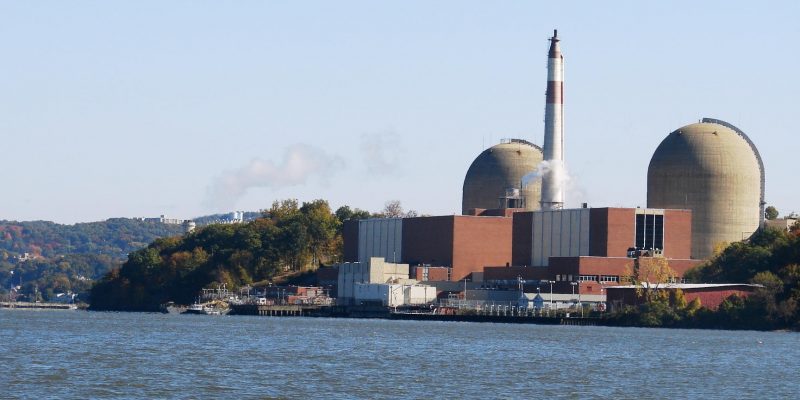
The Indian Point power plant sits on the banks of the Hudson River in Buchanan, NY, 25 miles north of New York City and 31 miles, as the crow flies, from Gardiner. In the event of an accident or terrorist attack, there is no evacuation plan for the 17-20 million people who live closest to the plant. Entergy Corporation, owner of the plant, has a plan to evacuate only a two mile radius around the plant, though Gardiner is one of the communities within the 50-mile “peak injury zone.”
The Department of Defense has written that the plant is vulnerable to a terrorist attack and the Nuclear Regulatory Commission (NRC) reports that of all the country’s nuclear reactors, Indian Point has the highest risk of being damaged by an earthquake; it sits on the intersection of two fault lines.
The plant consists of two reactors, both of which have been operating without a permit—one since 2013 and the other since 2015. Entergy is asking the NRC for a 20-year renewal of the lease for each reactor and the Commission’s review will determine if Indian Point stays open or is decommissioned.
In the past year, the plant has had 10 unplanned shutdowns for a variety of reasons. Among them: a power failure in the reactor core; a major oil spill; a pump failure; a transformer explosion which spewed oil into the Hudson; a leaking water pipe; an alarm failure; flooding in a room equipped with safety equipment; and radioactivity discovered in surrounding ground water. Shutdown #10 involved damage to 227 of the 832 bolts that secure the reactor walls which, according to the NRC, “significantly degrades plant safety.”
The unrelated company Spectra Energy is in the process of building a 42 inch, high- pressure gas pipeline that will run 105 feet from Indian Point’s cooling generators, stoking fears that a gas explosion could seriously damage the plant’s generators. Entergy claims that the plant could be shut down in time to avert a disaster, but neighbors are skeptical. Some protests have resulted in arrests, and a grassroots attempt to stop the pipeline that garnered 30,000 signatures, failed to halt construction.
Because nuclear power plants provide nearly 60% of carbon free power and run at 90% capacity, they are helpful in battling the effects of climate change. Some advocats even advocate for taxpayer bailout of our many aging plants, or subsidies like those available to some clean energy initiatives. But those who oppose the plants argue that we should be investing in solar and wind—and that there are 75 tons of nuclear waste currently stored at active power plants. Many worry that the waste is poorly stored and maintained. The next generation of nuclear plants may be able to burn spent fuel, but the process will be expensive, and nuclear plants are already having trouble competing with cheap natural gas and a lower demand for electricity.
The majority of US reactors are older than 30 years, and 33 aging reactors have been permanently shut down, including the Entergy owned Vermont Yankee Plant. In an agreement made possible by the cooperation of unions, environmentalists and the power company, the latest shut down is planned for the Diablo Canyon plant in California when licenses for its two reactors expire in 2024 and 2025. Pacific Gas and Electric will replace the energy the plant generates with solar and wind energy at a lower cost.
Advocates for nuclear energy lobby for investment in maintenance so as to improve safety in existing plants. Others would rather invest in renewables. Last year, the Obama administration pledged a combination of private sector commitments and executive actions to provide $4 billion for new, clean energy initiatives. Such action would also create jobs since any plant closing agreement would require “retain and retrain” provisions for workers. It is the fear of loss of jobs as well as concerns about having adequate energy that compel organizations like the Affordable Reliable Electricity Alliance and the Gateway Chamber of Commerce to lobby the NRC to keep Indian Point open. The plant generates 12.5% of power capacity for the downstate region.
A 2012 report commissioned by The Natural Resources Defense Council and Riverkeeper concluded that efficiency measures and new energy options could replace Indian Point at a cost of a about a dollar per month per household. NYS Assemblyman Kevin Cahill, former chair of the Assembly Committee on Energy says, “Indian Point can be shut down without unduly burdening New York’s ratepayers or the electric system. We have the framework and the resources for a future without Indian Point.” Governor Cuomo, also a proponent of closing the plant, is championing clean energy throughout the state, and his plan is to have NYS running on 50% renewable energy by 2030.
While there is no shortage of competing, passionate arguments on both sides of this debate, they are all in the communities immediately surrounding the plant. Those of us who live within Indian Point’s 50-mile “peak injury zone” have yet to express an opinion. Nevertheless, the issue is neither theoretical nor academic. Indian Point, 31 miles from our town, is a sobering reality.
